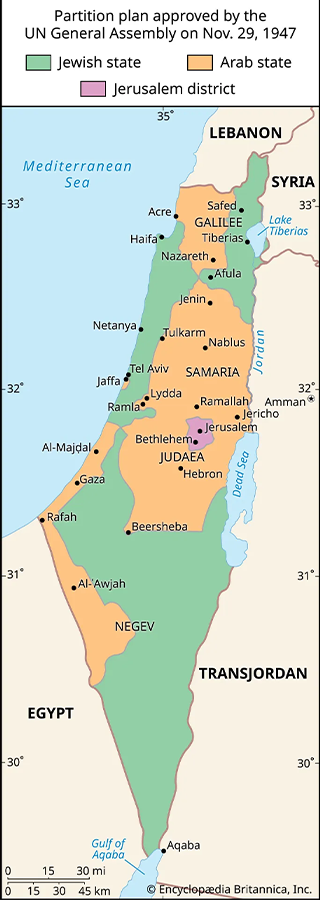The Partition Plan
Acknowledging the horrors of the Holocaust and the need for the Jews to have a safe place, the United Nations created The United Nations Partition Plan –a Plan for Palestine—a plan on how to divide the land between Jews and Arabs.
The plan included a Jewish state to be formed on about 55 percent of the land and an Arab state on about 45 percent of the land. Though the Arab land was a bit smaller, the land was better quality with greater access to water.
The UN General Assembly put the proposal to vote on November 29, 1947. The vote passed with a final vote of 33 for, 13 and 10 abstentions. The resolution for the creation of the State of Israel was adopted.
The ENTIRE Arab world rejected the mandate.
In 1948, a few hours before the British left the territory, David Ben Gurion declared “I announce the establishment of a Jewish and Democratic state, The State of Israel, and the state was born.
May 15, 1948-July 1949: The War of Independence: starting a day after the establishment of Israel, five neighboring Arab countries invaded the new state.[1]
[1] Noa Tishby, “Israel: A Simple Guide to the Most Understood Country on Earth. Simon and Schuster Press. 2021.

Palestinian Perspective-The Nakba: The Catastrophe A year after the Arab invasion to destroy the new State of Israel, the Arab armies withdrew. In the course of the fighting between 700,000 and 750,000 Arab residents of the land were permanently displaced.

Overview of the Wars: After the Creation of Israel
The War of Independence
(November 19, 1947- July 1949)
Israel was formed, Arab nations invaded. The war ended in a truce—not a peace agreement and the Green Line was created.
The Sinai War
(October – November 1956)
Egypt blocked two crucial waterways for Israel (the Titran Straits and the Suez Canal) and encouraged, their special unit of the army Fedayeen to attack. The Egyptian leader was Gamal Abdel Nasser. Israel joined the French and British in a failed attempt to take back the Suez Canal.
The Six Day War
(June 5 – June 10, 1967)
Against the backdrop of Syrian support for Palestinian militias attacking Israel, Egyptian President Nasser warned Israel against moving its forces. Naser was fed “fake news” or false intel. But this fake intel caused a crisis in which Egypt, Syria and Jordan planned to attack Israel.
On June 5, 1967 Israel sent 185 fighter jets as a preemptive strike to destroy the Egyptian, Syrian and Jordanian air forces and airbases, Syria, Jordan, Iraq, and Egypt immediately activated their planned attack and Libya, Lebanon, Saudi Arabia, Sudan, Morocco, Tunisia, and Algeria joined in the attack attempting to eliminate Israel.
Within six days, Israel won the war in a stunning victory and conquered new territory:
Golan Heights from Syria in the North
Gaza Strip and Sinai Peninsula from Egypt in South
West Bank from Jordan in the East
UN Security Council Resolution 242
(November 1967)
Five months after the Six Day War—the UN Security council adopted a resolution: Land for Peace. Israel adopted the resolution within a month, signaling to the world its intention to use occupied land as a bargaining chip for peace.
The War of Attrition
(June 1967 – August 1970)
The Egyptians wanted the Sinai Peninsula back and initiated numerous attacks on Israeli forces, mostly by artillery and sea raids. Israel responded with force.
The Yom Kippur War
(October 6 – 26, 1973)
An attack on the holiest day in the Jewish calendar, Israel was caught completely off guard. Egypt, Syria, and Iraq with active assistance from Libya, Algeria, Morocco, Saudi Arabia and Jordan coordinated an attack on Israel. Israel eventually and just barely won the war, but it was a close call for the survival of the country.
The First Lebanon War
(June 6 – September 29, 1982)
Starting around the late 1960s the Palestinian Liberation Organization (the PLO) settled itself inside Lebanon on the northern border of Israel and launched attacks on Israeli civilian targets. After approximately 270 terrorist attacks and a failed assassination on the Israeli ambassador to the UK, the Israeli military rode into Lebanon to remove the PLO. The war was named “Operation Peace for Galilee.” (Prime Minister Ariel Sharon tried to eliminate the PLO all the way to Beirut. Sharon’s failure to make these plans transparent to the public caused Israeli public opinion to turn against the government.)
The First Intifada
(1987 – 1993)
A Palestinian popular uprising against the Israeli occupation of the West Bank and the Gaza Strip (which Israel took from Jordan and Egypt in the Six Day War).
The Second Intifada
(2000 – 2005)
This uprising started when former defense minister Ariel Sharon visited the Temple Mount which includes the Al-Aqsa Mosque. During this time period, Palestinian suicide bombers indiscriminately killed Israeli civilians. Israel responded by retaking parts of West Bank and Gaza.
The Second Lebanon War
(July 12 – August 12 2006)
Israel cleared PLO from South of Lebanon, Iran created and supported the terrorist group and political party, Hezbollah. The organization is deployed on Israel’s northern border and is devoted to Israel’s destruction. In the summer of 2006 Hezbollah launched an attack on Israeli soil in which three soldiers were killed and two kidnapped, and it sparked a war. Hezbollah fired thousands of rockets on civilians in the north of Israel, and the war lasted for 32 days. Despite heavy criticism within Israel, which led to the resignation of the IDF chief of staff, this war is credited with deterring similar attacks in Israel for years to come.



